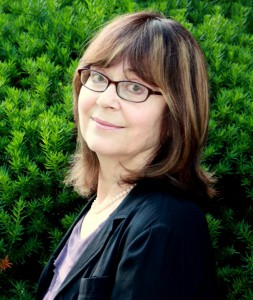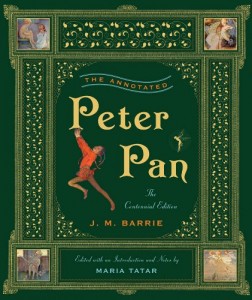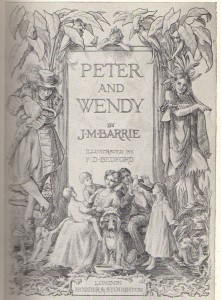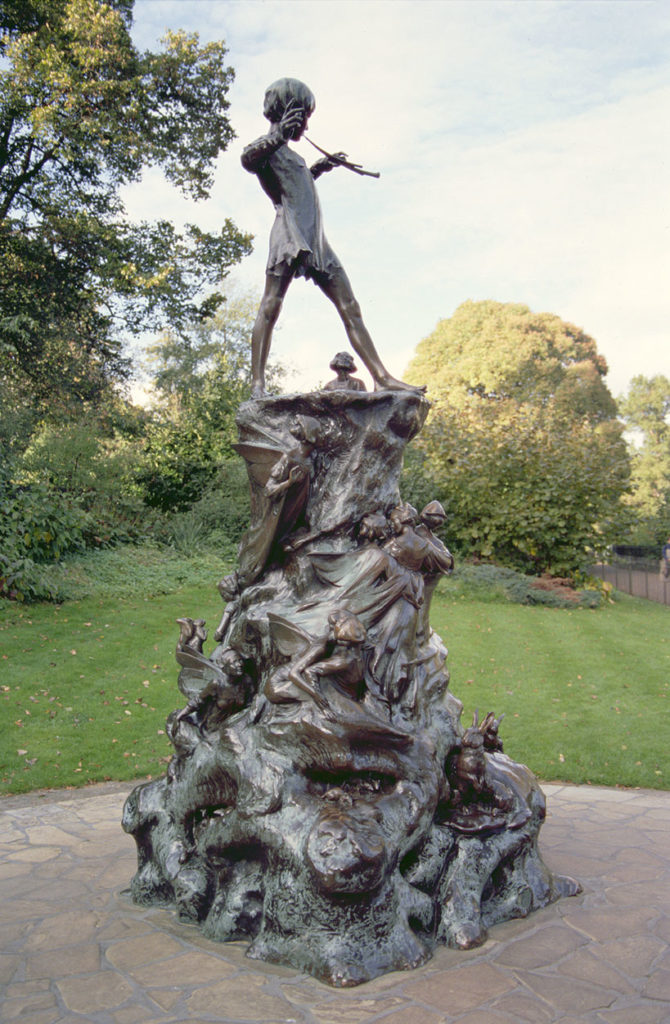By Nicki Richesin, The Children’s Book Review
Published: January 4, 2012

Maria Tatar is Professor of Germanic Languages and Literatures and Folklore and Mythology at Harvard University. Her latest book The Annotated Peter Pan is a glorious celebration of the centenary of the first publication of the novel, originally entitled Peter and Wendy by J.M. Barrie. It features a splendid array of photographs and illustrations, many reproduced for the first time, including The Boy Castaways of Black Lane Island. The book also includes a compilation of responses from famed artists, including Barrie’s contemporaries such as as Virginia Woolf and Mark Twain, to his work. For more on Tatar’s discoveries and Barrie’s creation of Peter Pan, please read on.
Nicki Richesin: I read The Annotated Peter Pan with such gripping wonder. It’s a marvelous book; congratulations to you. The story of Peter Pan has fascinated readers for generations and even proved a vehicle for a variety of adaptations in film, books, plays, and musicals. After your extensive research on this subject, what do you believe J.M. Barrie would think of its enduring appeal? Why do you believe his story has held such fascination for its audience?
 Maria Tatar: Peter Pan started out as a bedtime story and turned into a cultural myth. Barrie knew that he was onto something important, but I think even he would have been surprised that the story has endured as long as it has. There is more to Peter Pan than fairy dust and pirates. It’s a story about what it means to grow up—the gains and the losses that we incur when we become adults. Barrie felt the pain of the process more acutely than most of us do, and he also saw himself as something of a “betwixt and between”—no longer a child yet still not fully adult. It was more than just the “inner child.” He was able to go back in ways that few of us can, capturing the sense of adventure and eagerness for experience that is part of childhood desires.
Maria Tatar: Peter Pan started out as a bedtime story and turned into a cultural myth. Barrie knew that he was onto something important, but I think even he would have been surprised that the story has endured as long as it has. There is more to Peter Pan than fairy dust and pirates. It’s a story about what it means to grow up—the gains and the losses that we incur when we become adults. Barrie felt the pain of the process more acutely than most of us do, and he also saw himself as something of a “betwixt and between”—no longer a child yet still not fully adult. It was more than just the “inner child.” He was able to go back in ways that few of us can, capturing the sense of adventure and eagerness for experience that is part of childhood desires.
In your “Introduction to J.M Barrie’s Peter Pan,” you write, “We owe it to our children to give them books that do not put a politically correct dot on every “i” and that offer challenges, provocations, and an occasional sting that keeps us alive and thinking about those who lived before us.” You believe this would lead children to learn to search and explore and has been confirmed in your exhaustive study of fairy tales and in your books such as Enchanted Hunters. Could you further explain what you mean by this notion?
MT: I think it was Philip Pullman who told us that “thou shalt not is soon forgotten” and that “once upon a time” lasts forever. Great writers are above all else storytellers—occasionally even magicians—who give us worlds created by words. Children quickly grow wise to the ways of fiction and know that there are no easy messages, morals, and lessons in the books they read. There is no direct path from what is in the book to “truth,” nor is there a hotline to the meaning of life. When they read fiction, children develop a sense of curiosity about the lives of others (where else can you read minds and learn about what other people really think?), and they use their explorations of fictional worlds, along with their real-life experiences and exchanges, to develop a moral compass.
Peter Pan was my favorite story as a child. I read the edition edited by Josette Frank, beautifully illustrated by Marjorie Torrey, and published by Random House in 1957. We also had an edition illustrated by Arthur Rackham. Which version of this story do you prefer and why?
 MT: Arthur Rackham’s illustrations for Peter Pan in Kensington Gardens are exquisite, and I can’t imagine any rivals to those images. But I also love Mabel Lucie Attwell’s illustrations, although they are for a younger crowd. I have grown to love F.D. Bedford’s illustrations for the first edition of Peter Pan. At first they seemed fussy and cluttered to me, but now they feel like windows into each of the chapters in which they appear. They have an astonishing depth and texture. I’m reminded of how much I disliked, as a child, John Tenniel’s illustrations for Alice’s Adventures in Wonderland. Now they seem to capture the essence of Carroll’s story, and I can’t imagine reading the book without them.
MT: Arthur Rackham’s illustrations for Peter Pan in Kensington Gardens are exquisite, and I can’t imagine any rivals to those images. But I also love Mabel Lucie Attwell’s illustrations, although they are for a younger crowd. I have grown to love F.D. Bedford’s illustrations for the first edition of Peter Pan. At first they seemed fussy and cluttered to me, but now they feel like windows into each of the chapters in which they appear. They have an astonishing depth and texture. I’m reminded of how much I disliked, as a child, John Tenniel’s illustrations for Alice’s Adventures in Wonderland. Now they seem to capture the essence of Carroll’s story, and I can’t imagine reading the book without them.
You draw an interesting comparison between J.M. Barrie’s relationship with Peter Llewelyn Davies (really all five of the boys) and Charles Dodgson’s with Alice Liddell. Both authors were inspired by their young friends to create Neverland and Wonderland, worlds in which civilized society did not exist and to which children might escape. The two authors were revered and yet rumors were spread by those who frowned on adult men befriending children. Why do you believe both authors were enthralled with these particular children and deeply influenced by their little muses?

MT: We live in a culture deeply suspicious of anyone who takes an interest in other people’s children. Both Lewis Carroll and J.M. Barrie had a deep attachment to children, and they understood, in unprecedented ways, that there is beauty, humor, and poetry in the imagination of children. They lived in an era that famously developed a cult of childhood, but it was a cult that valued the beauty of children rather than their playful spirit and imaginative energy. Children were to be seen and not heard. Both Lewis Carroll and J.M. Barrie listened to the voice of the child and produced works that were, in some sense, collaborations. And, perhaps not coincidentally, both photographed children and appreciated the beauty of children at rest and at play. There is not a shred of evidence that there was anything improper in Barrie’s relationship to children, and the five Llewelyn Davies boys he adopted were quite firm about the fact that Barrie was a completely generous, benevolent presence in their lives.
While you were studying Barrie’s letters at Beinecke Library at Yale University, you wrote that you became very emotional. Although your response was in large part due to reading more about the boys’ feelings after the untimely death of their beloved mother and father Arthur and Sylvia Davies, I suspect it was deeper than this and due to finally reading about the boy who wouldn’t grow up and lived a life removed from the world. You discovered that few people truly knew Barrie apart from his adopted sons and housekeeper. What did you think when you read Barrie’s note, “May God blast any one who writes a biography of me” in his notebooks?
MT: Barrie described himself once as a shuttered house. I may have read his letters, notebooks, and diaries, but he remains a mystery to me—in a good sense. There were times when I felt myself to be an intruder in the archives, although there are those who will argue that posthumous papers belong to posterity. Occasionally I came across documents that seemed almost sacred—George’s letters to Barrie, written from the Western Front, just a few days before his death, to cite just one example. There was so much joy in Barrie’s life, and so many triumphs, but there is no getting past the tragic deaths of Arthur and Sylvia Davies, or George’s death in World War I, or Michael’s suicide at Oxford. Barrie was so guarded and private in real life that I felt it doubly important to treat his life with respect.
On your blog Breezes from Wonderland, you track the media and film world’s attempts to reinvent classic and fairy tales in film, music, plays and television. Which recent productions do you believe have been most successful?
MT: I rarely meet a fairy-tale revival or reinvention that I don’t like. I am enthralled by Catherine Breillat’s fairy-tale films, but I also find the new crime series Grimm, as well as the series Once Upon a Time, entertaining. I’m eager to see the three new Snow White films coming out in 2012, and I’m astonished that Hollywood, which has always used fairy-tale narratives as subtexts—is now explicitly reinventing the old tales
A.S. Byatt has written introductions for a few of your books (The Grimm Reader and The Annotated Brothers Grimm) and reviews of your books for The Guardian. How did you first begin working together and do you have future projects planned?
MT: A.S. Byatt has been wonderfully generous in writing the introduction for the Grimm books. Her work is always inspiring, and I am hoping that I will one day have the chance to meet her in person. We correspond from time to time, and I’m hoping to recruit her as a contributor to a handbook on fairy tales that I am editing.
Who do you believe are the most exciting children’s book authors of today and which ones do you think will make the sort of impact that readers will remember and cherish into their adulthood?
MT: I taught the Harry Potter series for the first time this year and was deeply impressed, once again, by the final book in the series—I think I now finally understand horcruxes and hallows, as well as the depth of Rowling’s engagement with the great existential mysteries. The devotion of my students to that series is nothing short of astounding, and the books have an unparalleled bonding power. It took me a while to become an ardent fan, perhaps because the books become more sophisticated and adult-friendly over time. Harry Potter grows up, and so does the generation of children that began reading his story when they were his age. I’m also a fan of Neil Gaiman, Lois Lowry, and Brian Selznick. And The Hunger Games is impossible to put down, even if it’s not a book to “cherish.” Children’s literature seems no longer to be just for children, and, these days, we live in a world of shared electronic media that has knocked down some of the old barriers.
What sort of projects are you currently working on?
MT: I have just finished a Young Adult novel about a boy growing up in Nazi-occupied Greece. It’s my first work of fiction, and it was inspired by a real-life story of an old friend of mine who lived in Athens during the second World War. Then it’s back to fairy tales.
Nicki Richesin is the editor of four anthologies,What I Would Tell Her: 28 Devoted Dads on Bringing Up, Holding On To, and Letting Go of Their Daughters; Because I Love Her: 34 Women Writers Reflect on the Mother-Daughter Bond; Crush: 26 Real-Life Tales of First Love; and The May Queen: Women on Life, Work, and Pulling it all Together in your Thirties. Her anthologies have been excerpted and praised in The New York Times, the San Francisco Chronicle, The Boston Globe, Redbook, Parenting, Cosmopolitan, Bust, Daily Candy, and Babble.
